| کد مقاله | کد نشریه | سال انتشار | مقاله انگلیسی | نسخه تمام متن |
|---|---|---|---|---|
| 5905969 | 1159943 | 2014 | 8 صفحه PDF | دانلود رایگان |
• A VEGF family evolutional phylogeny of 31 vertebrates was presented in our study.
• Functional differentiation evolved through gene duplication may be the important part.
• The phylogenetic tree showed that two major duplications in the vertebrate lineages.
• Eleven positive selection sites and one transmembrane region were detected in VEGF family.
Vascular endothelial growth factor (VEGF), known to play an important role in vascular homeostasis, vascular integrity and angiogenesis, is little known about the evolutionary relationship of its five members especially the role of gene duplication and natural selection in the evolution of the VEGF family. In this study, seventy-five full-length cDNA sequences from 33 vertebrate species were extracted from the NCBI's GenBank, UniProt protein database and the Ensembl database. By phylogenetic analyses, we investigated the origin, conservation, and evolution of the VEGFs. Five VEGF family members in vertebrates might be formed by gene duplication. The inferred evolutionary transitions that separate members which belong to different gene clusters correlated with changes in functional properties. Selection analysis and protein structure analysis were combined to explain the relationship of the site-specific evolution in the vertebrate VEGF family. Eleven positive selection sites, one transmembrane region and the active sites were detected in this process.
Journal: Gene - Volume 535, Issue 2, 10 February 2014, Pages 345–352
